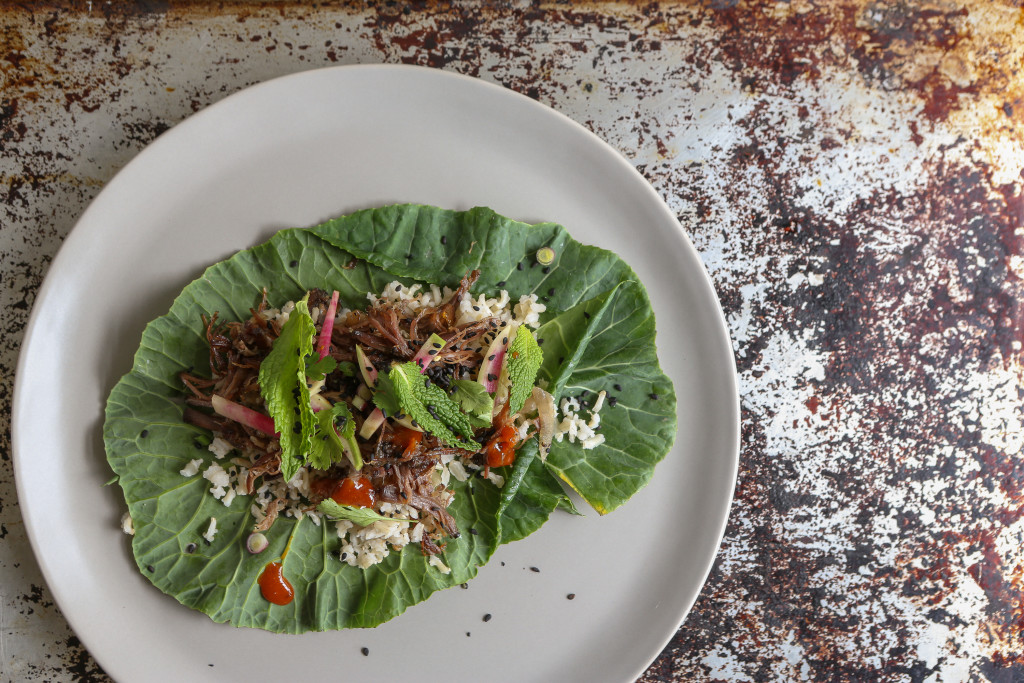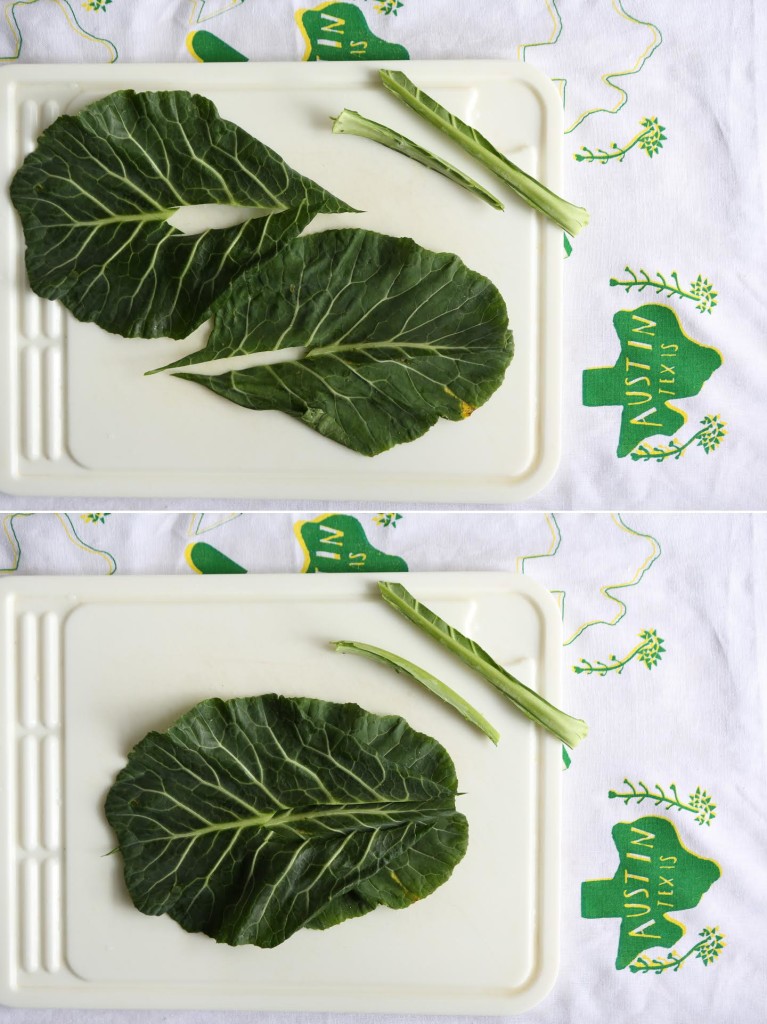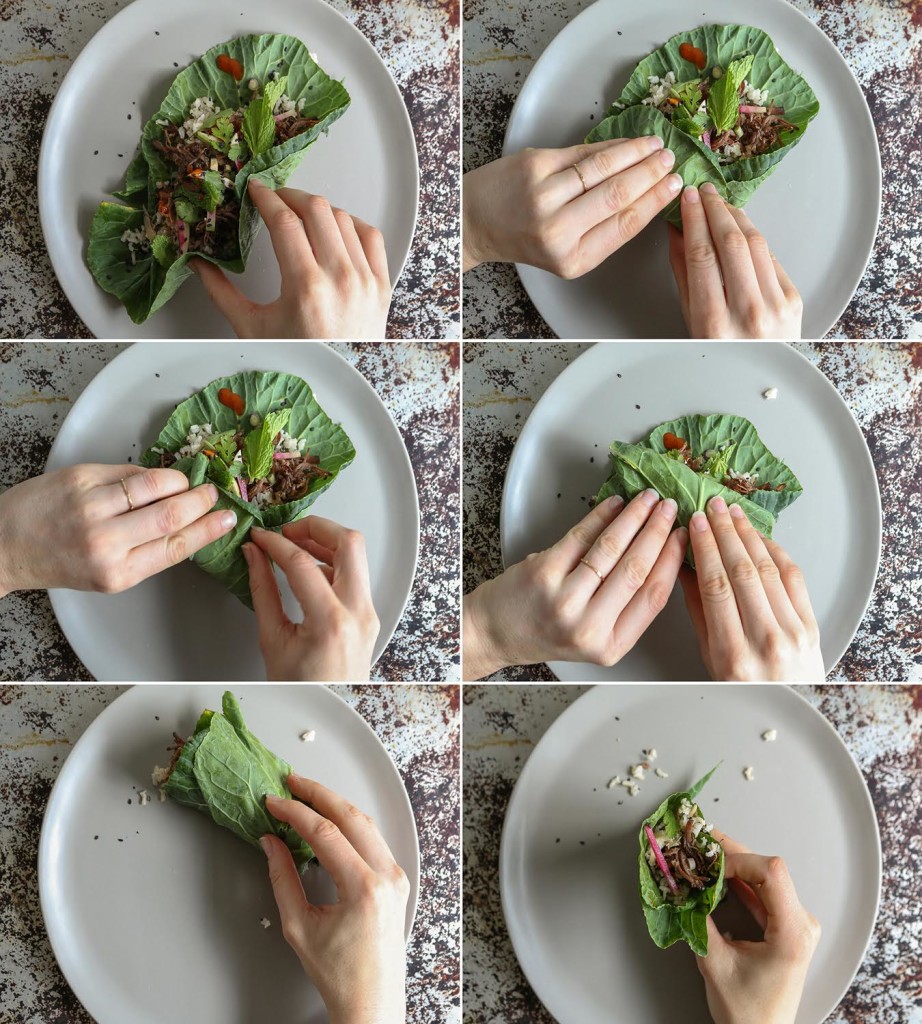
COLLARD WRAPS
03/01/17 — Heydon Hatcher
By Mackenzie Smith
Raw collards are sweet and crunchy; hearty enough to hold a meal-full of fillings. My first collard wraps were inspired by Vietnamese spring rolls: noodles, sprouts, pork, shrimp, mint & cilantro, served with fish sauce. They were a hit, and once I realized collards are the perfect vessel for anything savory, stuffing a big leaf full of leftover _____ with a sprinkle of this and that has become a meal we crave regularly.
![Photo by Mackenzie Smith.]() Photo by Mackenzie Smith.
Photo by Mackenzie Smith.
The wrap in this picture is made with leftover brown rice and shredded beef shortrib from Dai Due, watermelon radish, mint, cilantro, sesame, scallion and hot sauce.
Prep your fillings (chop veggies, herbs) and set them up so they are easy to get to as you build your wrap, starting with grains and ending with crunch or hot sauce.
Use your leftovers! Get creative!
Pick one of each:
Add a healthy sprinkle of any or all:
Crunch:
Finishing with a few shakes of hot sauce is non-negotiable in this house, but to each their own.
Maybe this reminds you of a more virtuous Chipotle situation? Get into it!
![Photo by Mackenzie Smith.]() Photo by Mackenzie Smith.
Photo by Mackenzie Smith.
Prep your collards:
Gently swish around whole collard leaves in a big bowl of water before letting them sit for about 10 minutes. Take the leaves out of the water and give them one more quick rinse under the faucet before patting them dry with a towel. (While this step may seem gratuitous, collards are inherently dirty, coming up from the earth the way they do. Nothing says “don’t do this again” like a mouthful of grit.) Aim to leave as much of the leaf in tact as possible as you remove the thickest part of the spine from each one. If the leaves are small, place one on top of the other to cover the slit from removing the spine reinforce your wrap and make room for more filling. If your leaves are on the larger side, just use one for each wrap, starting with the slit side and rolling inward.
Starting with the grain or noodle, spoon it into the middle of the leaf, then add protein, herbs and crunch. Finish with hot sauce. Air on the conservative side as you build your wrap, especially the first go-round. Once you have tried it a few times, you will begin to see about how much a leaf can handle based on its size.
![Photo by Mackenzie Smith.]() Photo by Mackenzie Smith.
Photo by Mackenzie Smith.
Raw collards are sweet and crunchy; hearty enough to hold a meal-full of fillings. My first collard wraps were inspired by Vietnamese spring rolls: noodles, sprouts, pork, shrimp, mint & cilantro, served with fish sauce. They were a hit, and once I realized collards are the perfect vessel for anything savory, stuffing a big leaf full of leftover _____ with a sprinkle of this and that has become a meal we crave regularly.
 Photo by Mackenzie Smith.
Photo by Mackenzie Smith.
The wrap in this picture is made with leftover brown rice and shredded beef shortrib from Dai Due, watermelon radish, mint, cilantro, sesame, scallion and hot sauce.
Prep your fillings (chop veggies, herbs) and set them up so they are easy to get to as you build your wrap, starting with grains and ending with crunch or hot sauce.
Use your leftovers! Get creative!
Pick one of each:
- Grain or noodle: brown rice, quinoa, noodles, couscous, freekeh, barley
- Protein: seitan, tofu, shrimp, chicken, beef, pork, poached/fried/scrambled egg, leftover sloppy joe filling, taco meat-- you get the picture
Add a healthy sprinkle of any or all:
- Mint, cilantro, basil, parsley, scallion, chives
Crunch:
- Julienned or shredded fresh carrots, watermelon radish, jicama or sprouts
- Pickles
- Nuts & seeds
- Crispy shallots or garlic
- Potato chips (yes)
Finishing with a few shakes of hot sauce is non-negotiable in this house, but to each their own.
Maybe this reminds you of a more virtuous Chipotle situation? Get into it!
 Photo by Mackenzie Smith.
Photo by Mackenzie Smith.
Prep your collards:
Gently swish around whole collard leaves in a big bowl of water before letting them sit for about 10 minutes. Take the leaves out of the water and give them one more quick rinse under the faucet before patting them dry with a towel. (While this step may seem gratuitous, collards are inherently dirty, coming up from the earth the way they do. Nothing says “don’t do this again” like a mouthful of grit.) Aim to leave as much of the leaf in tact as possible as you remove the thickest part of the spine from each one. If the leaves are small, place one on top of the other to cover the slit from removing the spine reinforce your wrap and make room for more filling. If your leaves are on the larger side, just use one for each wrap, starting with the slit side and rolling inward.
Starting with the grain or noodle, spoon it into the middle of the leaf, then add protein, herbs and crunch. Finish with hot sauce. Air on the conservative side as you build your wrap, especially the first go-round. Once you have tried it a few times, you will begin to see about how much a leaf can handle based on its size.
 Photo by Mackenzie Smith.
Photo by Mackenzie Smith.





 0 ITEMS IN CART
0 ITEMS IN CART 

